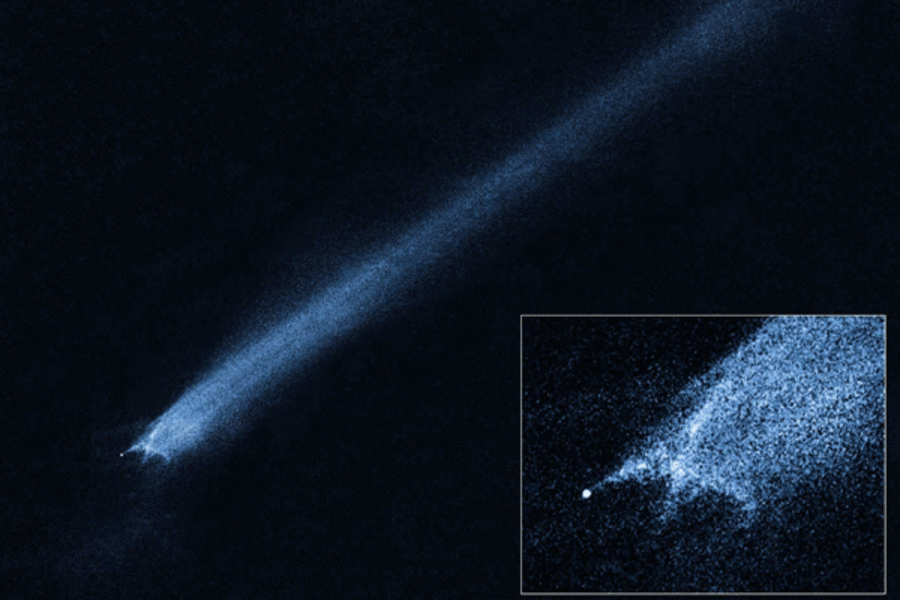Sky over Australia to be lit up by returning asteroid probe
Loading...
A Japanese spacecraft that visited an asteroid in 2005 is returning to Earth this weekend and should put on a brief, but spectacular, light show for fortuitously placed Australians late on Sunday.
The Hayabusa probe was launched by the Japanese Aerospace Exploration Agency (JAXA) on May 9, 2003 and rendezvoused with the Itokawa asteroid on September 12, 2005. [Photos of Japan's asteroid mission.]
Now it is set to land back on Earth, hopefully with asteroid bits in tow.
IN PICTURES: Asteroids
Like a Shooting Star
The Hayabusa spacecraft will enter the Earth's atmosphere at a rather shallow angle of 12 degrees and a speed of 7.6 miles per second (12.2 kilometers per second), and is expected to impact Earth in South Australia near the Australian Defense Force facility at Woomera. The Woomera Prohibited Area, as it is officially known, stretches for 49,000 square miles (127,000 square kilometers) in the northwest of South Australia.
The time of reentry is scheduled for 13:51 GMT Sunday, which corresponds to 11:21 p.m. local time for Woomera. Australia Department of Innovations' Michael Green said people in the vicinity should be able to see the spacecraft's reentry.
"There will be obviously a reentry trail that will be visible, weather permitting, and that will be like a shooting star in the sky as it comes in to Woomera," he said.
According to NASA, the fireball-like meteor effect created by Hayabusa might attain a peak brightness of magnitude -6.8. This would be 12 times brighter than the planet Venus, which is currently visible in the western sky for a couple of hours after sunset.
The range of visibility is somewhat uncertain, but could extend anywhere from about 400 to 700 miles (600 to 1,100 km) centered on Woomera. Places that have a good chance of seeing the reentry trail include Leigh Creek and Andamooka (to the north-northeast of Woomera) and Port Augusta (to the south-southeast of Woomera).
Adelaide, the capital of South Australia and Australia's fifth-largest city, with a population of more than 1.28 million, could be right on the edge of the visibility zone and might possibly see the bright streak very low on their north-northwest horizon.
Asteroid rendezvous
The Hayabusa spacecraft met with the asteroid 25143 Itokawa as planned and returned spectacular images of this cosmic rock, which measures roughly 1,700 by 800-feet (540 by 240 meters).
After arriving at Itokawa, Hayabusa studied the asteroid's shape, spin, topography, color, composition, density, and history.
On November 19, 2005, the spacecraft touched down on the surface of the Itokawa asteroid with its sample capturing device and attempted to collect a sampling of dust and pebbles, but the procedure did not go as planned. Mission scientists are convinced however, that there is a very good probability that some asteroid dust managed to swirl into Hayabusa's sampling chamber, so it was sealed.
During its journey home, the spacecraft lost some attitude control and is now limping back to Earth and is scheduled to return to on Sunday.
Other spacecraft, notably Galileo and NEAR Shoemaker, have passed close to asteroids before, but the Hayabusa mission, if successful, will mark the first time that an asteroid sample is returned to Earth for analysis.
On Sunday, the 1,124 lb (510 kg) space probe will reenter the Earth's atmosphere. Since the reaction control system no longer functions, the reentry is expected to mimic the approach of an asteroid along with the sample reentry capsule, and scientists are predicting that the majority of the spacecraft will disintegrate as it flies through the atmosphere.
The sample reentry capsule, roughly the size of a basketball and weighing 39.6 pounds (18 kilograms), should be able to make it back to Earth intact, the scientists say.
Watch it Live
An attempt will be made to provide a live video feed of the Hayabusa reentry around 13:51 GMT.
The video will be chosen from cameras operated onboard NASA's DC-8 Airborne Laboratory by Jesse Carpenter and Greg Merkes of NASA Ames Research Center, or those operated by Ron Dantowitz, Marek Kozubal, James Brietmeyer and Brigitte Berman of Clay Center Observatory, or those operated by Mike Taylor and Jonathan Snively of Utah State University.
The video feed will be transmitted by the DC-8 aircraft via INMARSAT, though it may not be of high quality.
See it here at: http://sgqtss.arc.nasa.gov:554/dc8-current.sdp
- Gallery - Hayabusa: Japan's Asteroid Mission
- NASA Sends Aircraft to Watch Asteroid Probe's Fiery Re-entry
- Astrophotography Telescopes for Beginners
Joe Rao serves as an instructor and guest lecturer at New York's Hayden Planetarium. He writes about astronomy for The New York Times and other publications, and he is also an on-camera meteorologist for News 12 Westchester, New York.
IN PICTURES: Asteroids





